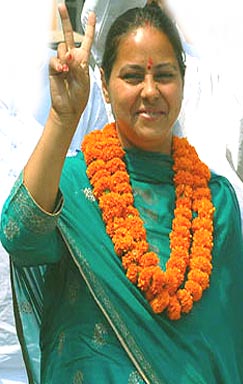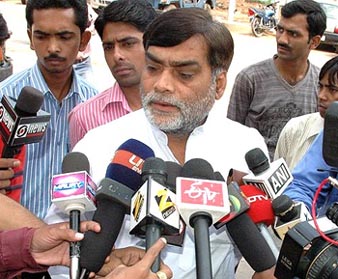|
13/04/2014
Patliputra: The fastest changing parliamentary constituency of Bihar |
The parliamentary constituency of Patliputra named after the capital of ancient Magadh empire is a ruralized western and southern part of Patna. Before the delimitation of 2009 there was no such Lok Sabha seat. Till recently it was a vastly agrarian region known for some of the most fertile land in the state. The entire constituency is very well fed by rivers Ganga, Punpun, Sone and Sone canals. The famous Patna rice still has market across the world. As parts of the constituency have been converted into the concrete jungle the shifting of river Ganga and depletion of water in Sone and its canals, because of the construction of dams in Madhya Pradesh and Uttar Pradesh, have affected the farming in the region. Now the farmers and owners of the land do not demand more irrigation facilities and timely supply of fertilizer. Instead the land-owners now go on warpath when they are not paid suitable compensation for the land acquired by the government––both Centre and state––for the construction of IIT, NIT, AIIMS and hordes of other institutions. Fatuha on the east of Patna was chosen for industrialization during the chief ministership of Karpoori Thakur in late 1970s. But in the last several years the focus has shifted to the western and southern parts, which witnessed construction boom. It has its side affect too and new problems are cropping up, but they are hardly becoming an election issue. The battle is just between Misa and Modi and nothing else. The electorate are bombarded with the same old figures of castes and communities. Here the number of educational institutions outnumber industries. A handful of plants are coming up, but ironically some of them are related to the wine and beer––at least one of them an international firm. It was in this part of Patna and neighbouring Bhojpur, which saw a farmers’ movement led by Swami Sahajanand Saraswati in 1930s. Five decades later the same region emerged as the stronghold of CPI ML and CPI Maoists––earlier MCC––and the landed affluent castes. It was on both sides of river Sone that the Naxal movements as well as Ranvir Sena, and other private armies, had their roots. Today the Sena might have vanished but its open organization, the Akhil Bharatiya Rashtrawadi Kisan Sanghatan, is very much alive. Its leader, Indu Bhushan, is the son of Brahmeshwar Singh, alias Mukhiaji, the founder of Ranvir Sena, who was killed by henchmen, alleged to have the backing of Janata Dal (United) MLA, Sunil Pandey. Incidentally, he belongs to the same caste Now Indu Bhushan is contesting the election as the candidate of Desi Kisan Party. His presence may somewhat queer the pitch of the BJP’s Ram Kripal Yadav, who is banking heavily on the votes of highly influential Bhumihar caste, which has a sizeable presence here. Though Yadavs are almost double in number yet it is Bhumihars, who are considered as king-maker as they often vote as one. The constituency has a sizeable EBC, Mahadalit and some Muslim (eight per cent) votes too. But the presence of a big Kurmi electorate, especially in the south of the constituency, is helping Janata Dal (United) make the contest a three-cornered one. The importance of Bhumihar votes can be measured from the fact that in no other block level township in Bihar––other than Bikram––has Narendra Modi addressed his election meeting. It is Misa’s father, Lalu Yadav, who first contested from Danapur in 1995. He promised to build a pontoon bridge and he got it built after the election. So the entire riverine (diara) area of the constituency could be linked to the state capital. Along with Maner, Danapur has a sizeable Yadav population. It is said that after 2009 delimitation Patliputra has largest Yadav voters in the state, even more than Madhepura. |

 Though a high-profile electoral battle is going on between Lalu Prasad Yadav’s daughter, Misa Bharati, and his former, Hanuman, Ram Kripal Yadav as well as ex-RJD working president and now a sitting Janata Dal (United) MP, Dr Ranjan Prasad Yadav, Patliputra is the one parliamentary constituency of Bihar, which has undergone the biggest change in the last few years.
Though a high-profile electoral battle is going on between Lalu Prasad Yadav’s daughter, Misa Bharati, and his former, Hanuman, Ram Kripal Yadav as well as ex-RJD working president and now a sitting Janata Dal (United) MP, Dr Ranjan Prasad Yadav, Patliputra is the one parliamentary constituency of Bihar, which has undergone the biggest change in the last few years. But the lush green surrounding is gradually vanishing. The mango orchards in the Danapur Assembly segment has all but disappeared while the three-crop land of Bikram, Paliganj, and Maner––the other two segments are Masaurhi (SC) and Phulwarisharif (SC)––have lost some of their productivity.
But the lush green surrounding is gradually vanishing. The mango orchards in the Danapur Assembly segment has all but disappeared while the three-crop land of Bikram, Paliganj, and Maner––the other two segments are Masaurhi (SC) and Phulwarisharif (SC)––have lost some of their productivity.
